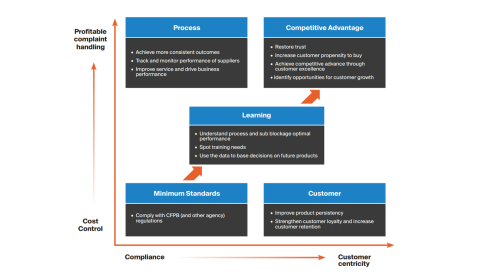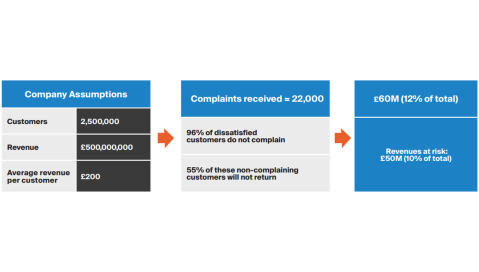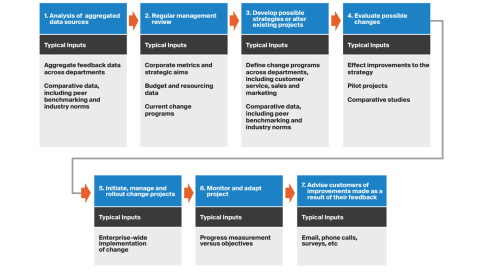How To Transform Your Complaint Handling Function Into a Source of Profitability
How To Transform Your Complaint Handling Function Into a Source of Profitability
How To Transform Your Complaint Handling Function Into a Source of Profitability
11 Aug 2022
Aptean Staff Writer
The greatest test of the relationship between the customer and their service or product provider is a complaint. However, managed correctly, it can deliver significant value to a business.
This blog addresses how you can explore the role and value of complaints and feedback within your organisation, examining how complaints can be turned from a costly inconvenience into an opportunity to develop profitable and sustainable customer relationships.
There are two key directives which underpin the best complaint management strategies:
Act on every complaint you receive
Leverage every opportunity to create value from each complaint—it’s not enough to simply process it
With these two directives at the heart of your complaint handling process, you can transform your complaint management into a key competitive differentiator and a real source of profit for your business.
A Strategic Approach To Handling Complaints
It is 5-25x more costly to attract a new customer than it is to retain an existing one. Competition, commoditisation of product offerings and rising acquisition costs have highlighted the importance of customer retention. While the cost of acquiring a new customer varies from organisation to organisation, there’s little disagreement on the high cost and lack of foresight involved in maintaining a strategy focused only on acquiring new customers.
Organisations should continually look for ways to identify, nurture and encourage customer loyalty. In order to shape a customer-focused, loyalty driven business for the future, this retention process must strive to understand customers’ expectations and requirements. There are various technologies and methodologies available to build customer insight and understanding of market sentiment. But, in actual fact, customers are already giving you vital, free information on how they feel about your business, your products and your services—it’s just that nobody seems to be listening.
Customer complaints and other forms of customer-initiated feedback represent the most reliable, accurate and fastest way to get quality data on customers’ attitudes. In most cases, these complaints come from loyal customers (not disloyal ones, as is often assumed). These customers are offering the organisation an opportunity to recover the failure, to make restitution and then continue with a mutually valuable relationship. Often, a simple apology is all they’re looking for.
Customers who do complain about their dissatisfaction are also more likely to re-purchase if they feel their complaint is heard and managed. Essentially, if they’re complaining, they care. Industry research shows that customers who complain and are satisfied are up to 8% more loyal than those who did not have a problem. And, they’re more likely to tell their families, friends and colleagues about how pleased they are that the company addressed their complaint, even if the issue was resolved to their dissatisfaction. If their problem was resolved satisfactorily, they’re prone to tell even more people than if they had simply received good service in the first place.
Given this propensity to repurchase and to recommend to others in their social groups, customer complaints are a leading indicator of customer sentiment and future economic activity.
Based on research conducted by the Aptean team, the diagram below highlights the various ways organisations handle complaints.

Those businesses that have evolved beyond a basic cost-control level appear to be making progress in one or more of the following areas: improvements in process efficiency; instilling organisational learning; and/or focusing on delivery to the customer.
As firms strive to make improvements in process efficiency, organisational learning and customer-focused delivery, we begin to see companies gaining competitive advantage as a service-led organisation by achieving excellence in complaints management and by using complaints data to drive improvements in the business.
Understanding the Financial Impact of Complaint Management
In the past, there’s been a tendency to assume ‘compensation culture’ is the main motivator for customers who complain. Interestingly, some companies are recognising the value of encouraging all customers with a grievance to make a complaint. There are a couple of reasons behind this:
Many products sold today are taking longer to reach profitability and companies are having to work harder to retain their customers, leading to a growing focus on improving the customer experience.
Increasingly, organisations are recognising the previously untapped potential of complaints as a means to identify systemic problems in their products and services. Listening to customer complaints and acting upon them helps with customer retention and satisfaction and also presents an opportunity for growth within the business itself. While these principles are easy to understand, many businesses want to understand the financial impact of an unaddressed complaint before investing further, and rightly so.
Although it can be challenging to put quantitative measures on qualitative aspects of feelings and disposition, it’s certainly not impossible.
Figure 2, conceived by Stauss and Seidel and adapted by us, traces populations of customers who have a negative experience with an organisation and the financial implications of whether they complain or not.


To illustrate how this works, let’s apply the model in Figure 2 to a company with 2,500,000 customers and a turnover of £500 million per year in Figure 3.
This gives an average revenue of £200 per customer per year. In this example, you can see that 22% of the organisation’s customers have had a poor experience. Studies show that on average, less than 4% of dissatisfied customers will actually complain and so for our example company, this would result in about 22,000 complaints. At an average £200 customer revenue per year, those 22,000 complaints equate to approximately £4.4 million in revenue. Undoubtedly, it’s financially responsible for you to listen to and take care of those complaining customers.
Now, let’s say that of the 4% of customers that complained, 38% were satisfied with the way their complaint was handled, making them likely to advocate for the brand and repeat purchase. But the other 62% of the complainants were disappointed with how their complaint was managed and addressed.
If 40% of these disappointed customers are lost as customers, this would result in about £1.1 million lost revenue per year. In relative terms, this loss may not be devastating, but it’s only the tip of the iceberg.
Remember, 96% of people who have had a poor experience do not complain—they remain the silent majority. Of these unhappy non-complainers, what if 55% (290,000 customers) left and 45% (238,000 customers) became at risk of leaving? That would equate to £58 million in lost revenue per year, with the potential to lose a further £47.5 million. These figures are the most concerning as they represent a population of customers who aren’t communicating with you and over whom you have little influence.
For every dissatisfied customer, there are another 10-20 people who now distrust the company and are unlikely to consider becoming a customer.
This lost/at risk income is enough to seriously damage profitability and you simply cannot afford to ignore dissatisfied customers anymore. The greatest opportunity for you to retain this income is to make your complaints handling process readily accessible to any customer who is dissatisfied. Encourage feedback from your customers and engage with them in a meaningful way.
The ramifications do not stop only at a loss of business. Customers who have a poor experience with an organisation will tell between 10-20 people. This means that for every dissatisfied customer, there are another 10-20 people who now distrust the company and are unlikely to consider becoming a customer.
Encouraging customers to speak up; making the complaints process transparent, accessible and seamless; and treating complaints seriously are key steps in driving up customer retention and, ultimately, your business’s profitability.
But it’s not enough simply to process the complaint—you need to leverage every opportunity to create value from it.
In the past, the majority of businesses have viewed complaint handling as a drain on the company’s resources. Processes have traditionally been more focused on clearing the complaint quickly rather than taking the necessary amount of time to manage the customer’s dissatisfaction to find a realistic solution. Recent research shows that 69% of businesses believe their customers to be satisfied with complaints handling, a figure that shrinks dramatically to just 26% of customers who reported being satisfied with the service they experienced.
Forward-thinking companies are increasingly focused on improving the consistency and effectiveness of their complaint and feedback management processes. They have made it part of their mission to deliver standards of service and outcomes that demonstrate a commitment to their customers.
Beyond addressing the needs of and eventually satisfying the customer, a good complaint management strategy should also place a strong emphasis on root cause analysis. Companies need to move beyond simply apologising—if an issue occurs again and again, you need to be able to identify the underlying cause and apply that understanding across your organisation.
The value of complaints data lies in its ability to leverage effective root cause analysis to identify the causes of dissatisfaction, delivering insight into customer attitudes and behavioural trends. This insight enables an organisation to understand issues from the customer perspective, directly monitoring product and service performance, and driving improvements to the business by addressing product or service-based barriers to increased customer satisfaction and loyalty.

Driving Improvements to the Business
Adopting an approach that manages complaints and recognises their potential for delivering value to the business is extremely worthwhile—both for the customer and for the organisation.
As demonstrated in Figure 4 above, eradicating the causes of dissatisfaction and driving business improvements is a continuous loop of:
Gathering customer feedback data and providing the evidence to the "voice of the customer"
Developing and implementing "change" strategies and evaluating, monitoring and adapting through the project lifecycle
Keeping the customer informed of the improvements implemented—reaffirming the organisation’s commitment to a customer-focused business
This approach to driving change through complaint and feedback management represents a true source of competitive advantage:
Reducing customer turnover
Improving customer retention
Strengthening customer loyalty
Increasing customer value
Elevating the company’s bottom line
In terms of competitive differentiation, it’s difficult for others to imitate because it relies on an investment in cultural change as well as business and process improvements.
While many companies have evolved from a minimal approach to managing customer complaints and feedback, most have yet to fully leverage their complaint handling process as a competitive advantage. You can harness this potential by:
Optimising the accessibility of your complaint and feedback processes
Investing in a robust and enterprise-proven complaint management solution like Aptean Respond to ensure all complaints are captured and handled effectively and efficiently
Listening to your customers’ experiences of making a complaint
Performing root cause analysis of complaint and feedback data in order to identify process and service improvements and prioritise business change initiatives
Placing your customer and their complaints at the heart of your business
For more information on how Aptean Respond can transform your complaints handling department into a source of profitability for your business, get in touch today to begin deriving real value from your customer complaint management.
Related Content


Ready to start transforming your business compliance?
We’ve got the specialised solutions you need to conquer your industry's complaint management challenges.






